Emphysema Can Lead to Which of the Following?
The respiratory tract begins with the nose, nasal sinuses and mouth and continues as the throat, larynx, trachea, and left and right bronchi. The bronchi branch repeatedly till they form very pocket-sized bronchioles called the terminal bronchioles. The terminal bronchioles atomic number 82 to the alveoli or air sacs. The alveoli are elastic and springy sacs, comparable to a balloon. Exchange of oxygen and carbon dioxide takes place through the thin walls of the alveoli. The respiratory bronchioles and the alveolar ducts connect the concluding bronchioles to the alveoli and also have part in exchange of gases.

The alveoli become inflated when air enters them. Due to their elasticity, they spring back to their original size following expiration. In emphysema, due to the loss of their stretchiness, the lungs fail to empty air efficiently during expiration, and trap air. Consequently, they incorporate more air than normal leading to a country of hyperinflation.
Normally, the alveoli help in keeping the airways open allowing free exchange of air. In emphysema, the damaged alveoli are unable to proceed the airways open up either during inspiration or expiration, which collapse as a result. This is i of the reasons for airflow obstruction in emphysema.
This land of hyperinflation of alveoli and complanate airways necessitates putting in extra effort to breathe, leading to breathlessness.
The Global Initiative for Chronic Obstructive Lung Disease (Aureate) however no longer distinguishes betwixt emphysema and chronic bronchitis in its definition of COPD.
Chronic obstructive pulmonary disease is a progressive condition, characterized by incomplete emptying of air from the lungs, and a resultant reduced airflow to the lungs. COPD encompasses chronic bronchitis, emphysema or a combination of the two.
Epidemiology of Emphysema
The World Health Organization estimates that there were 3 one thousand thousand deaths acquired past COPD in 2022 worldwide, which roughly translates to v percent of all deaths that year. Interestingly, more than xc percent of deaths due to COPD occur in low and centre income countries, since strategies for disease control and prevention are either not finer implemented or inaccessible in these parts of the world.
In the United states, as per the National Health Interview Survey from 2007, the prevalence of emphysema is 18 per m, and that of chronic bronchitis 34 per yard. While the prevalence rate of emphysema has remained largely the same since 2000, that of chronic bronchitis has come downward.
According to the Centers for Affliction Control and Prevention, the number of deaths recorded due to emphysema is around 7455 people in 2014.
Around iii.iv million people (ane.4%) in the United States are diagnosed with emphysema.People who mostly smoke may have severe emphysema.
Gender wise, the prevalence of COPD was earlier higher in men, attributable mainly to increased rates of smoking amid men. However with a ascension in smoking among women in the last xxx years, the gap has been bridged. In fact, it is suggested that women may be more susceptible to development of emphysema as compared to men.
What are the Types of Emphysema?
Depending on the part of the lungs affected, emphysema may be subdivided into
1. Centriacinar (centrilobular) type
2. Panacinar type
3. Paraseptal (Distal) type
- Centrilobular emphysema is the nigh commonly seen type of emphysema. It affects the respiratory bronchioles, mainly in the upper regions of the lung, while the alveoli are not affected. This type of emphysema is associated with cigarette smoking and exposure to grit.

- Panacinar emphysema involves the unabridged air sac uniformly, and occurs predominantly in the lower regions of the lung. Information technology is more than commonly seen in persons with a genetic mutation called α1 antitrypsin deficiency with homozygous PiZZ α1 antitrypsin mutation. However, this form can also occur in smokers along with centrilobular emphysema.
- Distal emphysema preferentially involves the alveolar ducts and sacs. The regions around the lung septa (partitions in the lungs) and pleura (tissue roofing the lung) are afflicted. Though air flow is not much restricted, the alveoli form large balloon-like structures called bullae. Large bullae may exert force per unit area and compress the surrounding lung tissue. The bullae in the upper part of the lungs tin can flare-up resulting in air in the chest, a condition called spontaneous pneumothorax.
What are the Causes of Emphysema?
The major causes of emphysema include:
- Fume - Tobacco fume is the primary cause of COPD. Nearly 85 to 90 per centum of COPD patients are past or electric current smokers. Passive smoking, where a person does not smoke but is exposed to cigarette smoke from the surrounding, also contributes to nigh xx per centum of cases. Women are more susceptible to the effects of cigarette smoke compared to men. Heavy exposure to marijuana smoke may also crusade COPD.
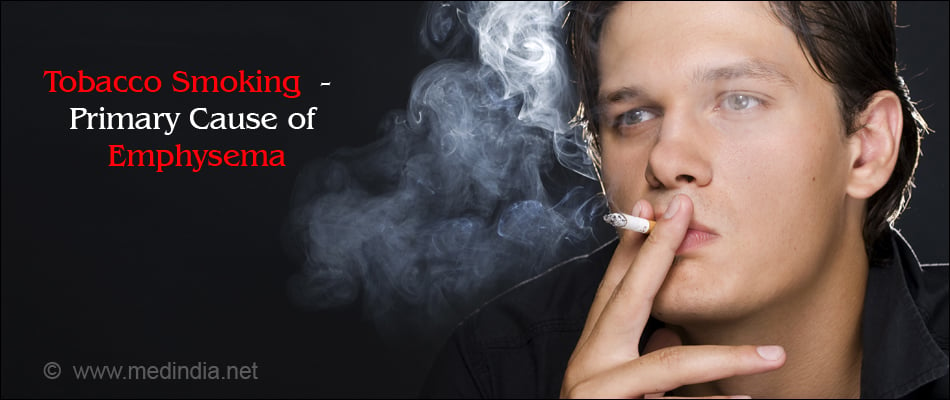
- Air pollution - Both outdoor and indoor air pollution are associated with an increased prevalence of COPD. Persons living in big cities, or those exposed to exhaust fumes from vehicular traffic and industries are usually afflicted. Notwithstanding, people in rural areas are also not spared. Poorly ventilated cooking fires using coal, cow dung or wood used in rural areas contribute to poor indoor air quality and can cause COPD. This grade of cooking is seen in developing nations such as Bharat, People's republic of china and Sub-Saharan Africa, and affects mainly women. Still, the contribution of air pollution to the development of COPD is minimal as compared to tobacco smoke.
- Occupational exposures - Exposure to dust, chemicals and fumes at identify of work enhances the take chances of COPD evolution. These contribute to around 10 to 20 percentage of cases.
Industries and occupations involving loftier exposure include coal, cotton textile, welding and those involving chemicals such as cadmium and isocyanates predispose to the development of COPD. Exposure to silica dust may likewise contribute to COPD development.
- Genetic factors - The genetic condition α1-antitrypsin deficiency (α1-AT) is a known risk factor for emphysema. Nevertheless, it has contributed to less than v percent of COPD cases. The role of other genetic factors is existence investigated. The incidence of COPD is higher in relatives of COPD patients who are also smokers, in comparing to unrelated smokers, which suggests that other genetic factors may too play a role. Hereditary factors may also provide an caption for the fact why some smokers never develop COPD, while non-smokers are diagnosed with this disease.
- Less well-divers factors - Poverty, asthma and hyperactive airways, depression nativity weight, and infections such as HIV/AIDS and tuberculosis may play a role in COPD evolution, though their role is non clear or well defined.
What are the Symptoms and Signs of Emphysema?
COPD is a disease of slow progression, and symptoms usually become overt around 50 to 60 years of historic period. Patients with homozygous PiZZ α1-AT deficiency may present around a decade earlier. Symptoms and signs of emphysema include the following:
- Gradual onset of breathlessness on exertion
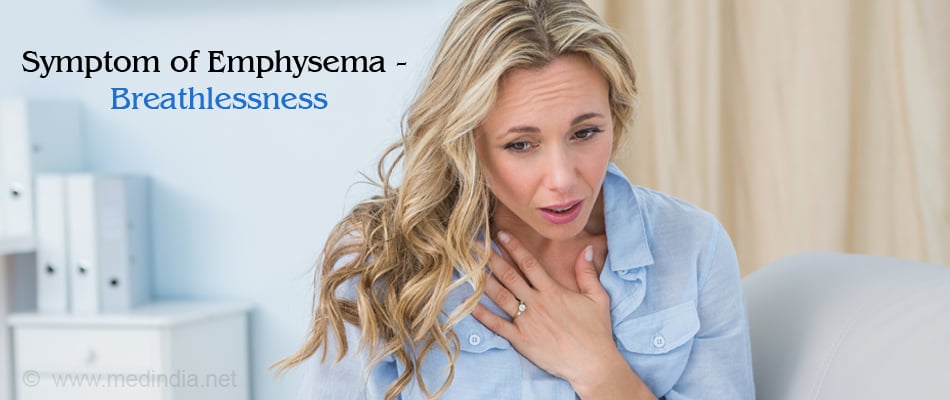
- Faster breathing with use of boosted chest muscles
- Progressively worsening breathlessness, ultimately leading to shortness of breath at rest and disability to perform daily tasks and climbing stairs. Sudden exacerbations may require admission to a infirmary
- Becoming easily tired and exhausted
- Reduced mental alertness
- Blue discoloration of nails and lips (cyanosis) due to reduced oxygen content of the blood
- Modify in the shape of the breast with an increase in the anteroposterior bore, referred to as butt chest
- On examination, the doctor may notice increased resonance on borer the breast, and decreased breath sounds on both sides of the breast with prolonged expiration. Additional sounds like wheeze are likely to be nowadays
- Patients with PiZZ α1-AT deficiency may experience liver dysfunction in babyhood
How is Emphysema Diagnosed?
History and physical examination - A diagnosis of emphysema may exist suspected based on the history of gradually progressive breathlessness, especially in smokers or those who are exposed to dust and pollutants constantly. Physical examination of the chest may confirm the diagnosis of emphysema, which can exist farther strengthened past the following tests.
Spirometry is a test that is useful to diagnose COPD, assess response to treatment and determine the progression of the illness. Various parameters are assessed depending on the patients� ability to breath into an musical instrument called a spirometer following specific instructions. Patients with COPD often accept the following findings:
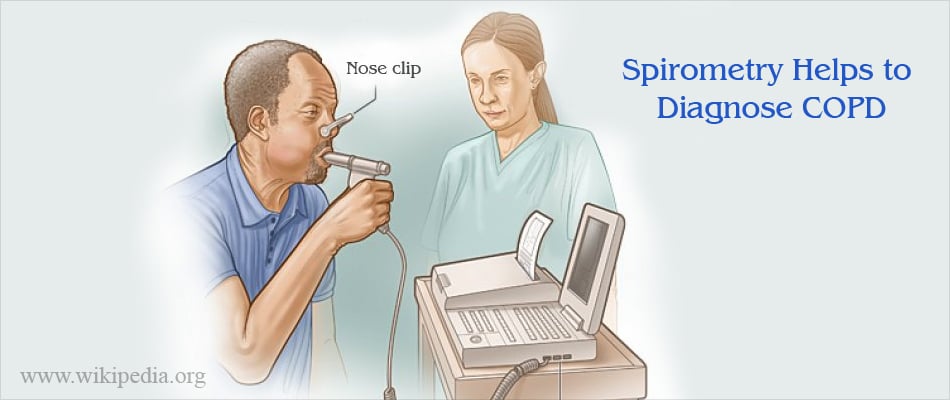
- Decrease in vital capacity - Vital capacity is the maximum book of air that is breathed out after a deep inspiration
- Reduced FEV1/FVC ratio -FEV1 is the amount of air expired in one second of forced expiration, while FVC is the amount of air breathed out post-obit a maximal expiratory try. In COPD, the FEV1 and therefore FEV1/FVC ratio is reduced due to airflow obstacle during expiration The FEV1/FVC ratio is also referred to equally Tiffeneau-Pinelli index that is used to diagnose the obstructive and restrictive lung disease.
- Forced expiratory time - A forced expiratory time is the time taken to breathe out. A forced expiratory time of more than than 6 seconds is diagnostic of COPD.
Chest x-ray � The findings on breast x-ray include signs of over-inflation of the lungs such as darker lungs, flattening of the diaphragm, increased airspace behind the chest bone and a long narrow heart. Features of pulmonary hypertension may also exist noted.
Claret tests -
- Arterial blood gas analysis � The claret oxygen levels should be evaluated at sleep, at rest, during movement, and during exertion. In the initial stages of the illness, the oxygen saturation of the blood may be reduced moderately (hypoxemia), with no evidence of increased carbon-di-oxide (hypercapnia). In the avant-garde stages, there is marked hypoxemia with development of hypercapnia.
- Hematocrit � Hematocrit refers to the percent of carmine blood cells in the blood. Reduced blood oxygen levels stimulate the body to produce more red blood cells, resulting in a condition called polycythemia. A hematocrit of more than than 52 percent in men and higher than 47 per centum in women is indicative of COPD.
- Serum bicarbonate levels � In COPD, serum bicarbonate levels increase. In the absenteeism of arterial blood gas measurements, estimation of serum bicarbonate levels may exist performed to appraise affliction progression.
- Serum α1-AT levels �The α1-AT levels may be measured if α1-AT deficiency is suspected. The normal level of α1-AT is 11 mmol/50 and above. A diagnosis of severe deficiency is confirmed by values between 3 and seven mmol/L. Genetic testing should be done for patients with values betwixt 7-11mmol/L.
Sputum testing - The sputum may show the presence of inflammatory cells and sometimes bacteria.
How is Emphysema Treated?
Emphysema cannot be cured. Handling is used to control the symptoms, retard the progression of disease, improve the quality of life and prolong survival. The following modalities of treatment are followed:
- General measures
- Medications
- Supportive therapy
- Surgery
General measures
General measures include:
- Quit smoking - This might perhaps be the single most important intervention that would retard disease progression. Patients should exist provided acceptable back up to help them to stop smoking. Second hand fume exposure must too be avoided.
- Fugitive exposure to irritants - Exposure to respiratory irritants like air pollutants, burning incense and candles and automobile exhaust fumes that could exacerbate COPD should be avoided.
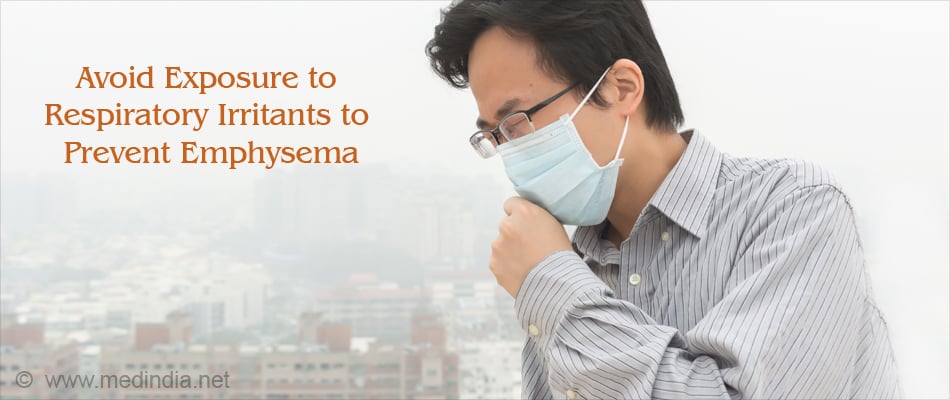
- Regular practise - Regular exercise helps improve total lung chapters and should be encouraged.
- Avoiding exposure to cold draughts - Protection from common cold is essential in COPD, since cold air will tuck the air passages and exacerbate the already existing obstructive symptoms.
- During common cold conditions, it is advisable to habiliment a scarf or even wear a cold air mask to comprehend the nose and mouth, to heat the air entering the lungs.
- Prevention of respiratory infections - People with emphysema should avoid respiratory infections. Getting the annual influenza vaccinations and pneumococcal vaccinations as advised by the physician, and staying away from people with cold or flu tin help to forestall respiratory infections. Wearing a protective mask when moving in crowds, especially in the cold atmospheric condition, and carrying a paw sanitizer while traveling may exist boosted measures to forestall infections.
Medications
Medications are used to control the symptoms of the illness. Some of the ordinarily used drugs include:
- Inhaled steroids - Steroids inhaled in the form of aerosols can relieve breathlessness. They may include corticosteroids similar beclomethasone, fluticasone, budesonide and formoterol. Prolonged steroid use is associated with a risk of developing diabetes, hypertension (raised blood pressure), cataracts, weak basic and stomach ulcers.
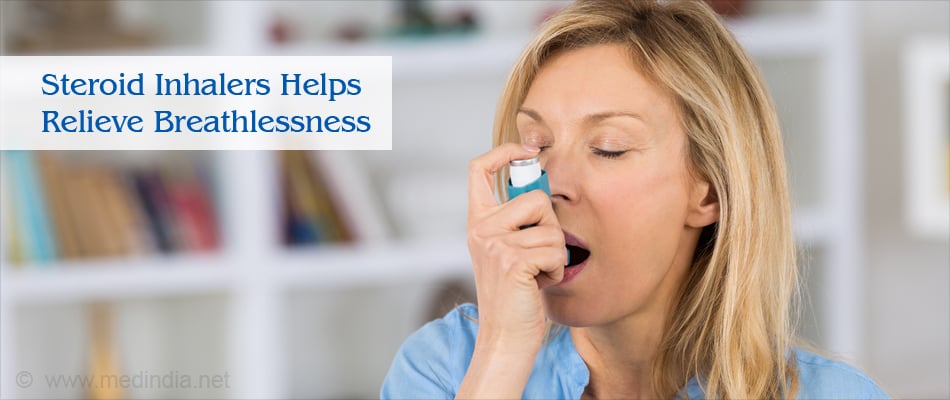
- Bronchodilators - These drugs relieve breathlessness acquired by narrowing and obstacle of air passages past relaxing the smoothen musculus of the airways (bronchi). Examples of bronchodilators include a combination of ipratropium with salbutamol Yet, they don�t seem as effective in the treatment of emphysema as compared to their efficacy in asthma or chronic bronchitis.
- Antibiotics - Antibiotics are necessary when patients with emphysema develop a bacterial infection with symptoms of fever and productive cough.
Patients with Alpha-i antitrypsin (AAT) deficiency may require treatment with drugs like danazol and tamoxifene which increase the production of AAT by the liver, or AAT replacement through inhalation or injection.
Supportive therapy
Supportive measures amend the person�s general condition and improve oxygenation of the lungs.
- Nutrition and nutrition - A balanced and healthy diet is essential for optimal health. In the early stages of the disease, many patients are advised weight loss measures, whilst in the later stages, patients are often emaciated and need to put on weight.
- Supplemental oxygen - In emphysema, the oxygen levels in the blood are often low, and many patients benefit by supplemental oxygen administered via a tube that fits into the nostrils. Some patients in the advanced stages need 24 hour oxygen supplementation.
- Pulmonary rehabilitation - This involves learning breathing exercises and techniques to amend lung capacity, decrease breathlessness and develop better tolerance to exercise or even daily activities.
Surgery
Different types of surgery are offered to patients to give symptomatic relief and restore lung function.
- Lung Volume Reduction Surgery � In this procedure, wedges of damaged lung tissue are removed. This will enable the remaining normal lung tissue to aggrandize and work more than efficiently, and eases animate.
- Bullectomy � Removal of behemothic bullae that occupy a big part of the breast, compress the adjacent lung and lead to a subtract in FEV1 to less than 50 percent of expected value, may result in expansion of the surrounding normal lung and improve lung function.
- Lung transplant � A lung transplant indicated when patients neglect to better with all other treatment modalities.
melbourneamigh1952.blogspot.com
Source: https://www.medindia.net/patients/patientinfo/emphysema.htm
0 Response to "Emphysema Can Lead to Which of the Following?"
Post a Comment